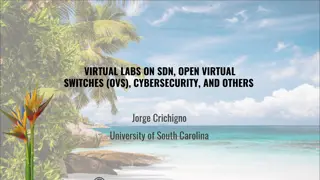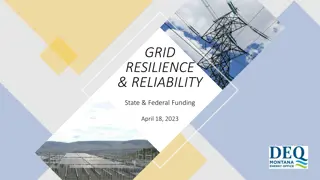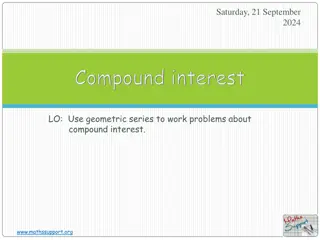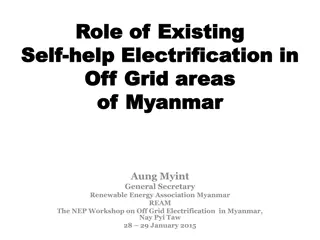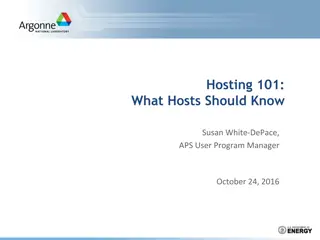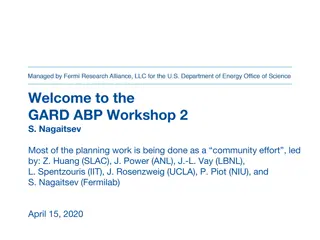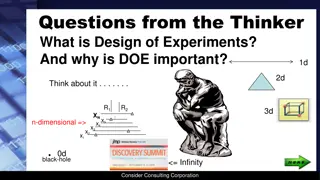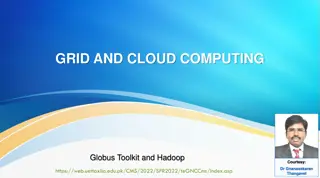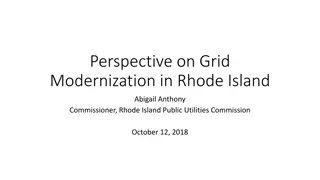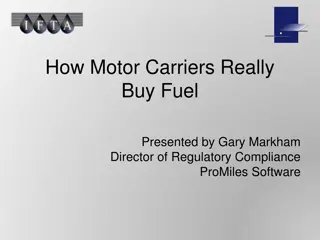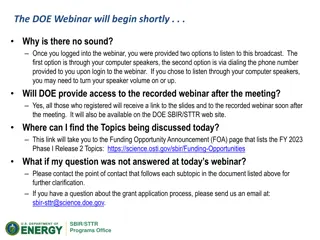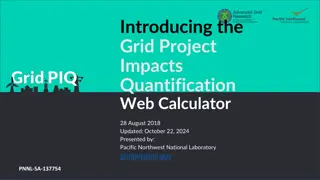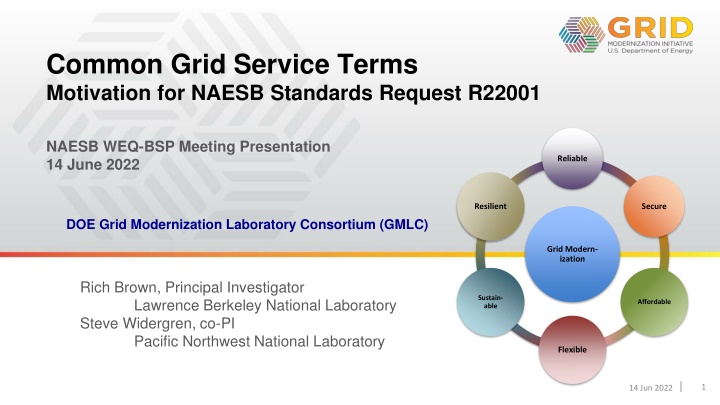
DOE & National Labs Interest in Grid Services Trends
Operating the electric grid is becoming increasingly complex due to the growth of variable renewable resources and electrification of various end-use applications. This presentation discusses the challenges and opportunities for integrating flexible grid-edge resources to enhance system coordination and operation efficiency.
Download Presentation

Please find below an Image/Link to download the presentation.
The content on the website is provided AS IS for your information and personal use only. It may not be sold, licensed, or shared on other websites without obtaining consent from the author. If you encounter any issues during the download, it is possible that the publisher has removed the file from their server.
You are allowed to download the files provided on this website for personal or commercial use, subject to the condition that they are used lawfully. All files are the property of their respective owners.
The content on the website is provided AS IS for your information and personal use only. It may not be sold, licensed, or shared on other websites without obtaining consent from the author.
E N D
Presentation Transcript
Common Grid Service Terms Motivation for NAESB Standards Request R22001 NAESB WEQ-BSP Meeting Presentation 14 June 2022 Reliable Resilient Secure DOE Grid Modernization Laboratory Consortium (GMLC) Grid Modern- ization Rich Brown, Principal Investigator Lawrence Berkeley National Laboratory Steve Widergren, co-PI Pacific Northwest National Laboratory Sustain- able Affordable Flexible 1 14 Jun 2022
Topics DOE and national labs interest in grid services GMLC common grid services and energy systems interface project Standards request R22001 Example grid service types Desired outcome of effort Potential implications for retail-level flexible resource coordination 2 14 Jun 2022
DOE & National Lab Grid Service Interest Trends: operating the electric grid is growing in complexity Variable renewable resource growth challenges the traditional operating paradigm Electrification of more end-use applications increasing demand Affordable communications and intelligence appearing at distribution level (infrastructure and customers) Greater opportunities for flexible grid-edge resources to coordinate their operation with the system Flexible grid-edge resources: responsive generation, storage, and demand Challenge: integration and interoperation of vast numbers of devices, systems, and participants Significant equipment purchased, operated, and maintained by non-grid entities Technology is changing and mixture is constantly evolving Many technology suppliers with various novel solutions Many jurisdictions with different rules, regulations, and business processes 3 14 Jun 2022
GMLC Grid Service and ESI Project Overview & Problem Statement To cost-effectively coordinate the operation flexible grid-edge resources at scale of millions need simplified ways to integrate and interoperate these resources Common grid services Types of performance-based agreements between grid operations and customer-owner-operations Must be adjustable for different regional jurisdictions Industry consensus to encourage reference and adoption Standard Energy Services Interface (ESI) Facilitate development of communication interface standards agnostic to flexibility equipment type The ESI is applicable to all types of equipment that can perform the agreed upon service Boundaries of responsibility on either side of the interface are clear and protected Embraces distributed decision-making coordination Results in modularity and loose coupling of the interacting system components. Multi-lab participation: LBNL (lead lab), PNNL, NREL, ORNL, ANL 4 14 Jun 2022
Why Engage at NAESB Wholesale electricity markets already designed to work with changing resource mix Wholesale grid services embrace a variety of resource mixes Independent system operation and markets service all participants Strive for level playing field Room for improvement Jurisdictions use somewhat different names for similar grid-services Ensure that operational objectives (purpose/use) separate from service definition Commonality breeds consistency and clarity to ease integration and interoperation of all participants NAESB appropriate forum for industry discussion and deliberation Members include system operations and market organizations with subject matter expertise Work products address industry terminology and business processes/practices Provides a consensus-based process 5 14 Jun 2022
Standards Request R22001 Objective: Classify common grid services that accommodate the diverse grid needs in different regions Define common grid service types for wholesale power system interactions Derive commonalities and important variations found in existing grid services Meet near to mid-future needs gathered from major US ISO/RTOs and utilities Accommodate specialization: performance characteristics and expectations Qualification, performance expectations, monitoring, reconciliation, and settlement vary by operational policy of each region But defining common policy is beyond the scope of this proposal Benefit: Provides consistent service-type names, definitions, and performance characteristics Encourages adoption of consistent terminology in wholesale markets Provides starting place for retail-level grid service interactions with flexible, grid-edge resources 6 14 Jun 2022
Service-Oriented Principles Operational objectives describe why a service is used Use cases helpful for describing the desired performance characteristics from a service Examples: schedule energy to meet peak load forecast, or reserve energy for outage contingency Boundaries of responsibility are clearly understood between service requester and provider Service definition says what is to be performed not how Example: generation needs to be at nominal power level 100 MW in 10 minutes and maintained for 1 hour Any equipment type that meets the performance requirement can provide the service Service provider understands what to do, where, and when not why The service requestor s reasons for invoking the service (the operational objectives) are hidden Example: a gas-turbine generator does not need to know it is scheduled for peak-load coverage Benefits Decouples areas of concern - makes integration simpler, cleaner, modular Same service can be used to address multiple objectives Accommodates service provider technology decisions within performance requirements 7 14 Jun 2022
Example Grid Service Types Grid Operational Objectives Provider Operational Objectives Courtesy of Chris Irwin (DOE) and Cortland Johnson (PNNL) 8 14 Jun 2022
Illustrative Performance Expectations 9 14 Jun 2022
Examples of Multiple Terms FERC 888 (1996) Scheduling, System Control and Dispatch Grid Service Types NERC IOS (2002) CAISO PJM Hawaiian Electric Day-Ahead & Real- Time energy Energy scheduling Energy Energy Inertia; Primary Frequency Response; Fast Frequency Response Frequency Response Frequency Response Regulation and Frequency Response Regulation Up; Regulation Down Regulation (Traditional and Dynamic) Synchronized Reserve; Non- Synchronized Reserve; Secondary Reserve Regulation Regulation Regulating Reserves Operating Reserve - Spinning Reserve and Supplemental Reserve Spinning Reserve; Non-Spinning Reserve Contingency Reserve Reserve Flexible Ramping (in Real-time Market) Energy Imbalance Load Following Load Reduce; Load Build Reactive Supply and Voltage Control from Generation Sources Reactive Power Supply from Generation Sources System Blackstart Capability Voltage Management Voltage Support Voltage Control Voltage Support Emergency Black Start Service 10 14 Jun 2022
Desired Outcome of Effort Classification of a (small) set of grid services Common names for these grid-service types Clear definitions of the service types Parameterized performance expectations (i.e., electrical attributes, timing attributes) Accommodate necessary specialization Effort does NOT, Propose a uniform market policy on services Prescribe a solution for DER integration into wholesale electric markets Specify DER management technology or platforms Recoup lost investments in cryptocurrencies 11 14 Jun 2022
Retail-level Flexible Resource Implications Should the wholesale electric area gain alignment on grid service type names and definitions Retail electric area offered a starting point for retail grid services Appropriate for customers or aggregators with flexibility resources Shift focus from equipment-oriented unique initiatives to service-based initiatives Reduce special programs for PVs, EV charging, electric storage, and demand response Increase service programs that focus on performance, not equipment type Simplifies integration and participation of flexibility resources in distribution operations Potential NAESB implication Provide preliminary material for Retail Electric Quadrant service terms and definitions 12 14 Jun 2022


